Marketing Plan for Toyota 2000 GT Solar-Powered Electric Car
VerifiedAdded on 2020/03/28
|10
|2631
|88
Report
AI Summary
This report presents a comprehensive marketing plan for the Toyota 2000 GT solar-powered electric car. It begins with an executive summary, followed by an introduction to the car and its historical significance. The report outlines the steps involved in creating a marketing plan and includes a SWOT analysis to assess the product's strengths, weaknesses, opportunities, and threats. It defines the company's mission and objectives, focusing on market share, brand recognition, and target audience. The marketing mix strategy, including product, pricing, and distribution strategies, is thoroughly discussed. The plan details promotional activities, including media advertising, event sponsorships, and showroom displays, and concludes with an implementation and control section. The report aims to provide a practical and effective strategy for launching and promoting the Toyota 2000 GT in the competitive automotive market.

MARKETING PLAN
FOR
CLASSIC TOYOTA 2000 GT SOLAR-POWERED ELECTRIC CAR
September 19, 2017
FOR
CLASSIC TOYOTA 2000 GT SOLAR-POWERED ELECTRIC CAR
September 19, 2017
Paraphrase This Document
Need a fresh take? Get an instant paraphrase of this document with our AI Paraphraser
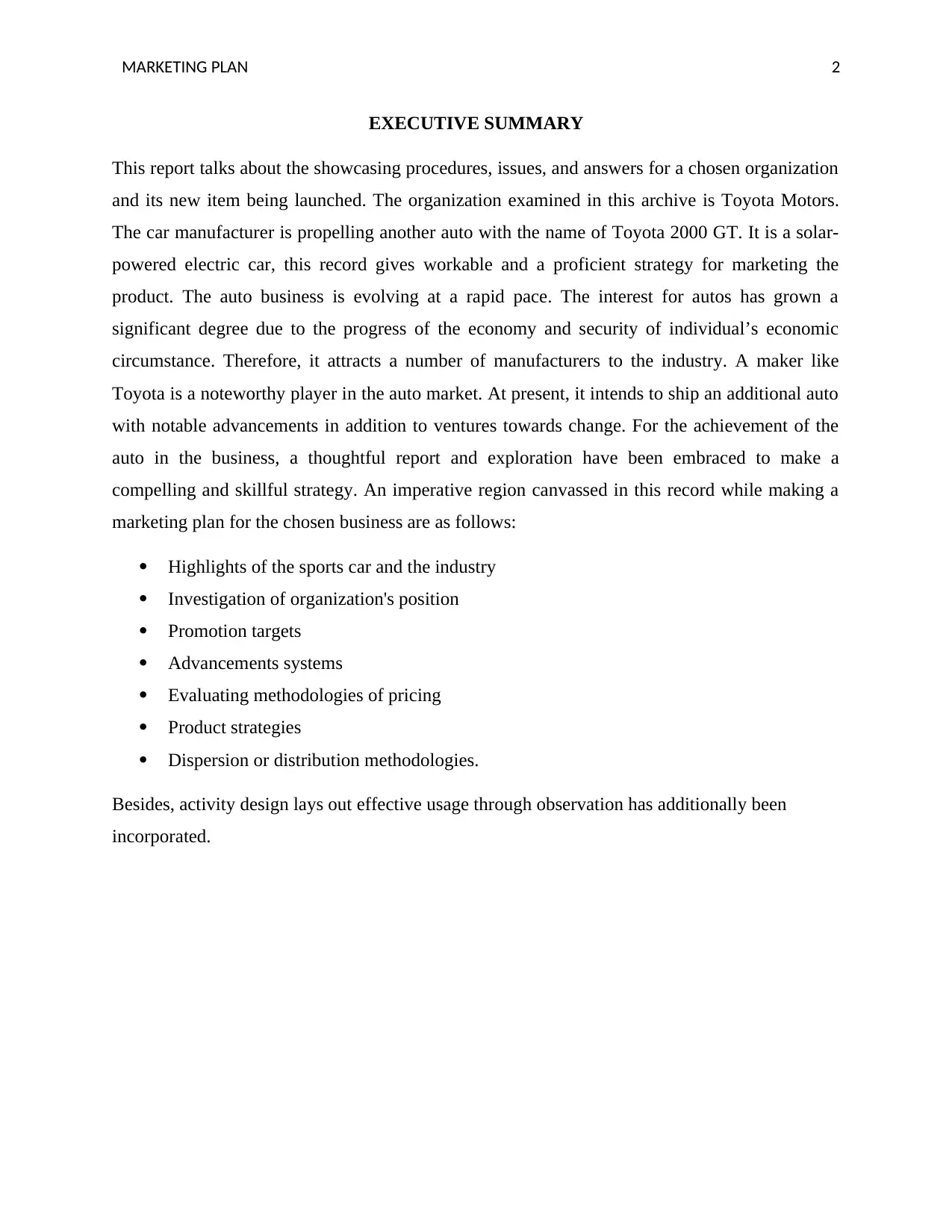
MARKETING PLAN 2
EXECUTIVE SUMMARY
This report talks about the showcasing procedures, issues, and answers for a chosen organization
and its new item being launched. The organization examined in this archive is Toyota Motors.
The car manufacturer is propelling another auto with the name of Toyota 2000 GT. It is a solar-
powered electric car, this record gives workable and a proficient strategy for marketing the
product. The auto business is evolving at a rapid pace. The interest for autos has grown a
significant degree due to the progress of the economy and security of individual’s economic
circumstance. Therefore, it attracts a number of manufacturers to the industry. A maker like
Toyota is a noteworthy player in the auto market. At present, it intends to ship an additional auto
with notable advancements in addition to ventures towards change. For the achievement of the
auto in the business, a thoughtful report and exploration have been embraced to make a
compelling and skillful strategy. An imperative region canvassed in this record while making a
marketing plan for the chosen business are as follows:
Highlights of the sports car and the industry
Investigation of organization's position
Promotion targets
Advancements systems
Evaluating methodologies of pricing
Product strategies
Dispersion or distribution methodologies.
Besides, activity design lays out effective usage through observation has additionally been
incorporated.
EXECUTIVE SUMMARY
This report talks about the showcasing procedures, issues, and answers for a chosen organization
and its new item being launched. The organization examined in this archive is Toyota Motors.
The car manufacturer is propelling another auto with the name of Toyota 2000 GT. It is a solar-
powered electric car, this record gives workable and a proficient strategy for marketing the
product. The auto business is evolving at a rapid pace. The interest for autos has grown a
significant degree due to the progress of the economy and security of individual’s economic
circumstance. Therefore, it attracts a number of manufacturers to the industry. A maker like
Toyota is a noteworthy player in the auto market. At present, it intends to ship an additional auto
with notable advancements in addition to ventures towards change. For the achievement of the
auto in the business, a thoughtful report and exploration have been embraced to make a
compelling and skillful strategy. An imperative region canvassed in this record while making a
marketing plan for the chosen business are as follows:
Highlights of the sports car and the industry
Investigation of organization's position
Promotion targets
Advancements systems
Evaluating methodologies of pricing
Product strategies
Dispersion or distribution methodologies.
Besides, activity design lays out effective usage through observation has additionally been
incorporated.
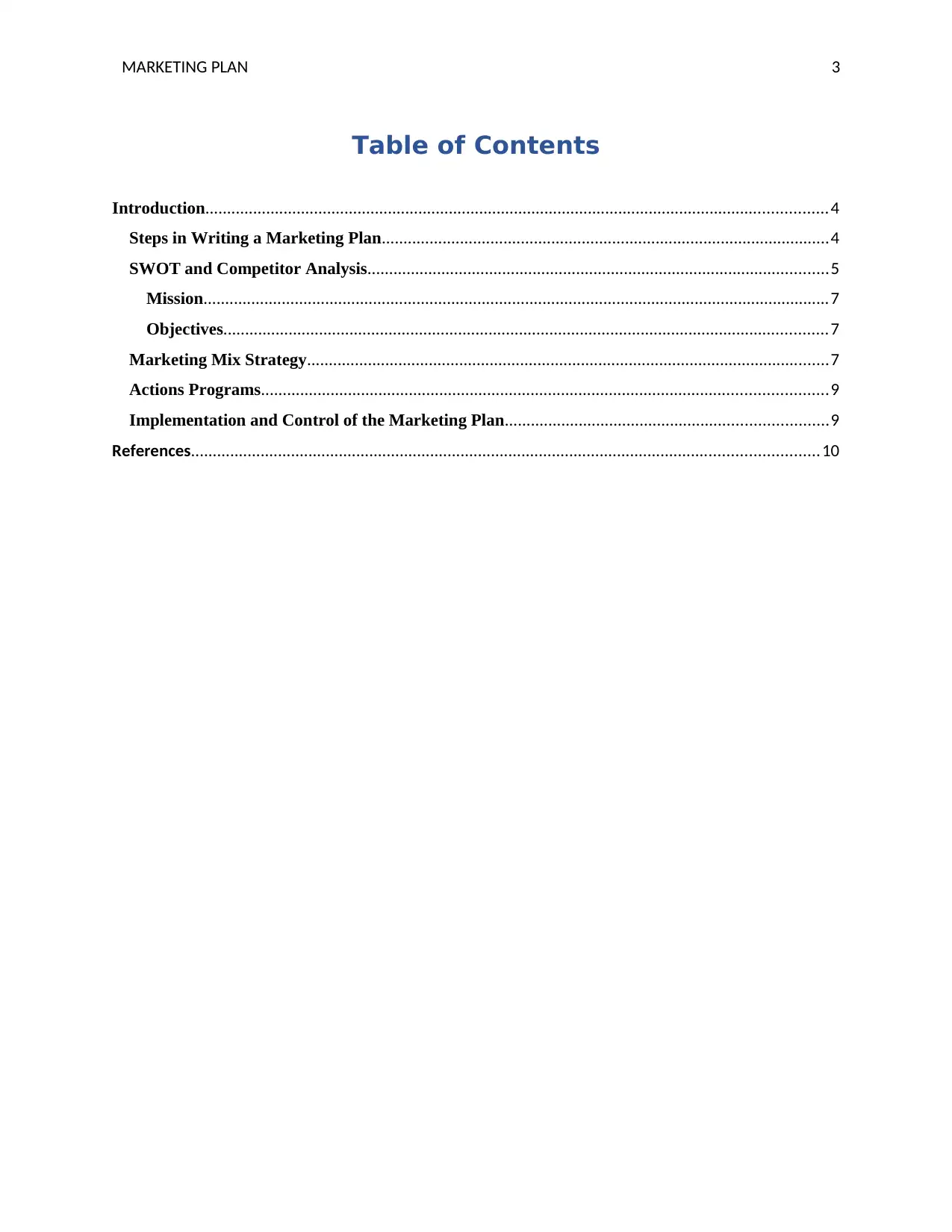
MARKETING PLAN 3
Table of Contents
Introduction...............................................................................................................................................4
Steps in Writing a Marketing Plan.......................................................................................................4
SWOT and Competitor Analysis..........................................................................................................5
Mission................................................................................................................................................7
Objectives...........................................................................................................................................7
Marketing Mix Strategy........................................................................................................................7
Actions Programs..................................................................................................................................9
Implementation and Control of the Marketing Plan..........................................................................9
References................................................................................................................................................10
Table of Contents
Introduction...............................................................................................................................................4
Steps in Writing a Marketing Plan.......................................................................................................4
SWOT and Competitor Analysis..........................................................................................................5
Mission................................................................................................................................................7
Objectives...........................................................................................................................................7
Marketing Mix Strategy........................................................................................................................7
Actions Programs..................................................................................................................................9
Implementation and Control of the Marketing Plan..........................................................................9
References................................................................................................................................................10
⊘ This is a preview!⊘
Do you want full access?
Subscribe today to unlock all pages.

Trusted by 1+ million students worldwide
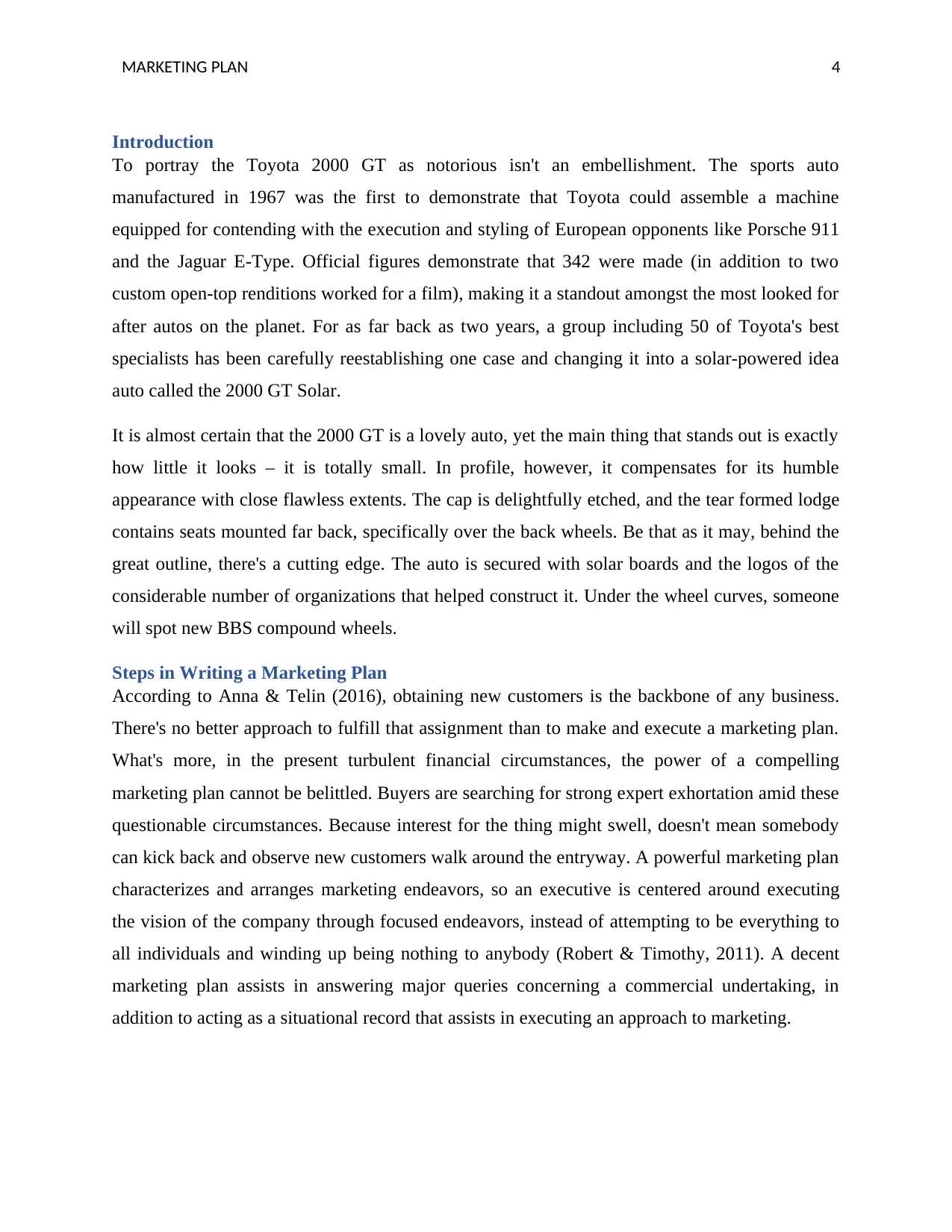
MARKETING PLAN 4
Introduction
To portray the Toyota 2000 GT as notorious isn't an embellishment. The sports auto
manufactured in 1967 was the first to demonstrate that Toyota could assemble a machine
equipped for contending with the execution and styling of European opponents like Porsche 911
and the Jaguar E-Type. Official figures demonstrate that 342 were made (in addition to two
custom open-top renditions worked for a film), making it a standout amongst the most looked for
after autos on the planet. For as far back as two years, a group including 50 of Toyota's best
specialists has been carefully reestablishing one case and changing it into a solar-powered idea
auto called the 2000 GT Solar.
It is almost certain that the 2000 GT is a lovely auto, yet the main thing that stands out is exactly
how little it looks – it is totally small. In profile, however, it compensates for its humble
appearance with close flawless extents. The cap is delightfully etched, and the tear formed lodge
contains seats mounted far back, specifically over the back wheels. Be that as it may, behind the
great outline, there's a cutting edge. The auto is secured with solar boards and the logos of the
considerable number of organizations that helped construct it. Under the wheel curves, someone
will spot new BBS compound wheels.
Steps in Writing a Marketing Plan
According to Anna & Telin (2016), obtaining new customers is the backbone of any business.
There's no better approach to fulfill that assignment than to make and execute a marketing plan.
What's more, in the present turbulent financial circumstances, the power of a compelling
marketing plan cannot be belittled. Buyers are searching for strong expert exhortation amid these
questionable circumstances. Because interest for the thing might swell, doesn't mean somebody
can kick back and observe new customers walk around the entryway. A powerful marketing plan
characterizes and arranges marketing endeavors, so an executive is centered around executing
the vision of the company through focused endeavors, instead of attempting to be everything to
all individuals and winding up being nothing to anybody (Robert & Timothy, 2011). A decent
marketing plan assists in answering major queries concerning a commercial undertaking, in
addition to acting as a situational record that assists in executing an approach to marketing.
Introduction
To portray the Toyota 2000 GT as notorious isn't an embellishment. The sports auto
manufactured in 1967 was the first to demonstrate that Toyota could assemble a machine
equipped for contending with the execution and styling of European opponents like Porsche 911
and the Jaguar E-Type. Official figures demonstrate that 342 were made (in addition to two
custom open-top renditions worked for a film), making it a standout amongst the most looked for
after autos on the planet. For as far back as two years, a group including 50 of Toyota's best
specialists has been carefully reestablishing one case and changing it into a solar-powered idea
auto called the 2000 GT Solar.
It is almost certain that the 2000 GT is a lovely auto, yet the main thing that stands out is exactly
how little it looks – it is totally small. In profile, however, it compensates for its humble
appearance with close flawless extents. The cap is delightfully etched, and the tear formed lodge
contains seats mounted far back, specifically over the back wheels. Be that as it may, behind the
great outline, there's a cutting edge. The auto is secured with solar boards and the logos of the
considerable number of organizations that helped construct it. Under the wheel curves, someone
will spot new BBS compound wheels.
Steps in Writing a Marketing Plan
According to Anna & Telin (2016), obtaining new customers is the backbone of any business.
There's no better approach to fulfill that assignment than to make and execute a marketing plan.
What's more, in the present turbulent financial circumstances, the power of a compelling
marketing plan cannot be belittled. Buyers are searching for strong expert exhortation amid these
questionable circumstances. Because interest for the thing might swell, doesn't mean somebody
can kick back and observe new customers walk around the entryway. A powerful marketing plan
characterizes and arranges marketing endeavors, so an executive is centered around executing
the vision of the company through focused endeavors, instead of attempting to be everything to
all individuals and winding up being nothing to anybody (Robert & Timothy, 2011). A decent
marketing plan assists in answering major queries concerning a commercial undertaking, in
addition to acting as a situational record that assists in executing an approach to marketing.
Paraphrase This Document
Need a fresh take? Get an instant paraphrase of this document with our AI Paraphraser
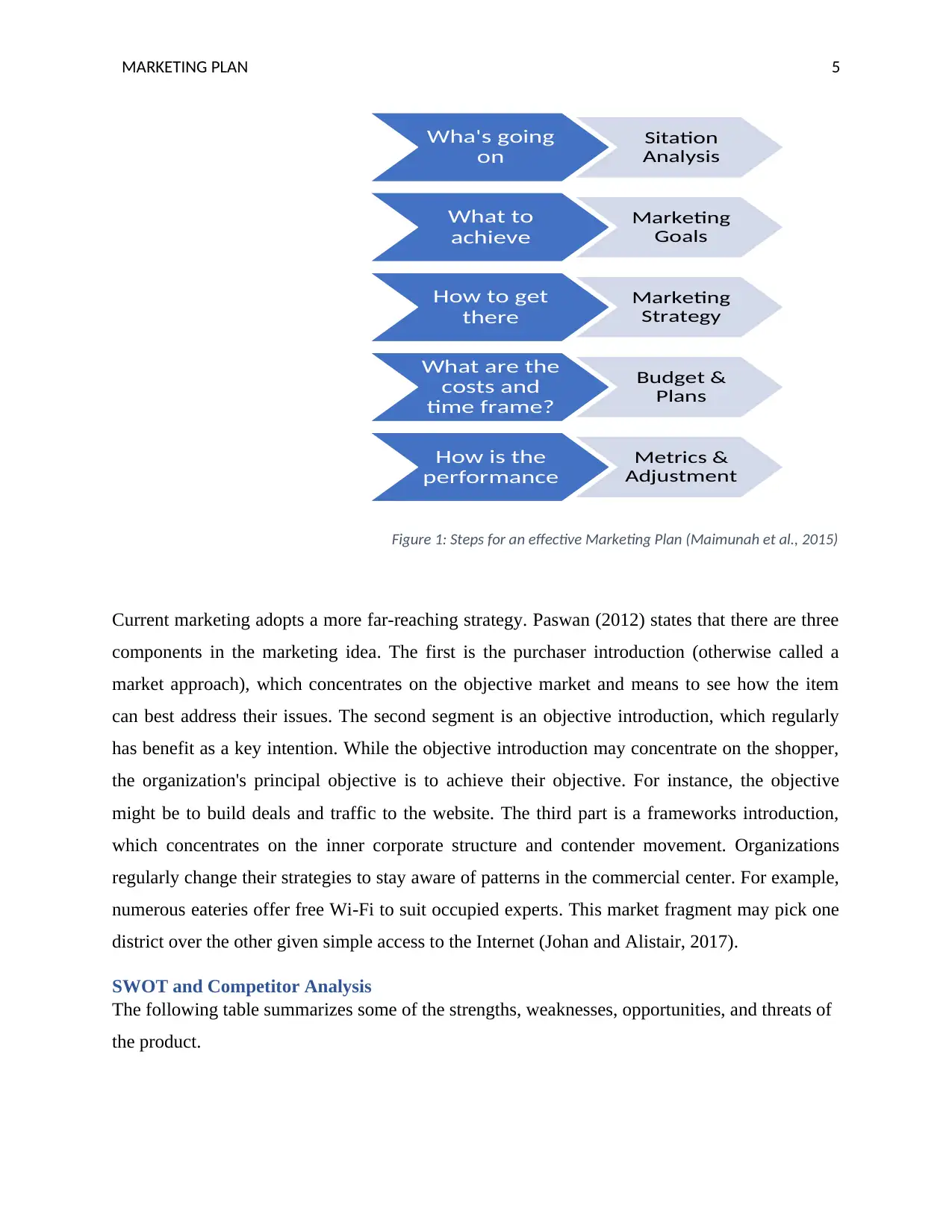
MARKETING PLAN 5
Figure 1: Steps for an effective Marketing Plan (Maimunah et al., 2015)
Current marketing adopts a more far-reaching strategy. Paswan (2012) states that there are three
components in the marketing idea. The first is the purchaser introduction (otherwise called a
market approach), which concentrates on the objective market and means to see how the item
can best address their issues. The second segment is an objective introduction, which regularly
has benefit as a key intention. While the objective introduction may concentrate on the shopper,
the organization's principal objective is to achieve their objective. For instance, the objective
might be to build deals and traffic to the website. The third part is a frameworks introduction,
which concentrates on the inner corporate structure and contender movement. Organizations
regularly change their strategies to stay aware of patterns in the commercial center. For example,
numerous eateries offer free Wi-Fi to suit occupied experts. This market fragment may pick one
district over the other given simple access to the Internet (Johan and Alistair, 2017).
SWOT and Competitor Analysis
The following table summarizes some of the strengths, weaknesses, opportunities, and threats of
the product.
Wha's going
on
Sitation
Analysis
What to
achieve
Marketing
Goals
How to get
there
Marketing
Strategy
What are the
costs and
time frame?
Budget &
Plans
How is the
performance
Metrics &
Adjustment
Figure 1: Steps for an effective Marketing Plan (Maimunah et al., 2015)
Current marketing adopts a more far-reaching strategy. Paswan (2012) states that there are three
components in the marketing idea. The first is the purchaser introduction (otherwise called a
market approach), which concentrates on the objective market and means to see how the item
can best address their issues. The second segment is an objective introduction, which regularly
has benefit as a key intention. While the objective introduction may concentrate on the shopper,
the organization's principal objective is to achieve their objective. For instance, the objective
might be to build deals and traffic to the website. The third part is a frameworks introduction,
which concentrates on the inner corporate structure and contender movement. Organizations
regularly change their strategies to stay aware of patterns in the commercial center. For example,
numerous eateries offer free Wi-Fi to suit occupied experts. This market fragment may pick one
district over the other given simple access to the Internet (Johan and Alistair, 2017).
SWOT and Competitor Analysis
The following table summarizes some of the strengths, weaknesses, opportunities, and threats of
the product.
Wha's going
on
Sitation
Analysis
What to
achieve
Marketing
Goals
How to get
there
Marketing
Strategy
What are the
costs and
time frame?
Budget &
Plans
How is the
performance
Metrics &
Adjustment
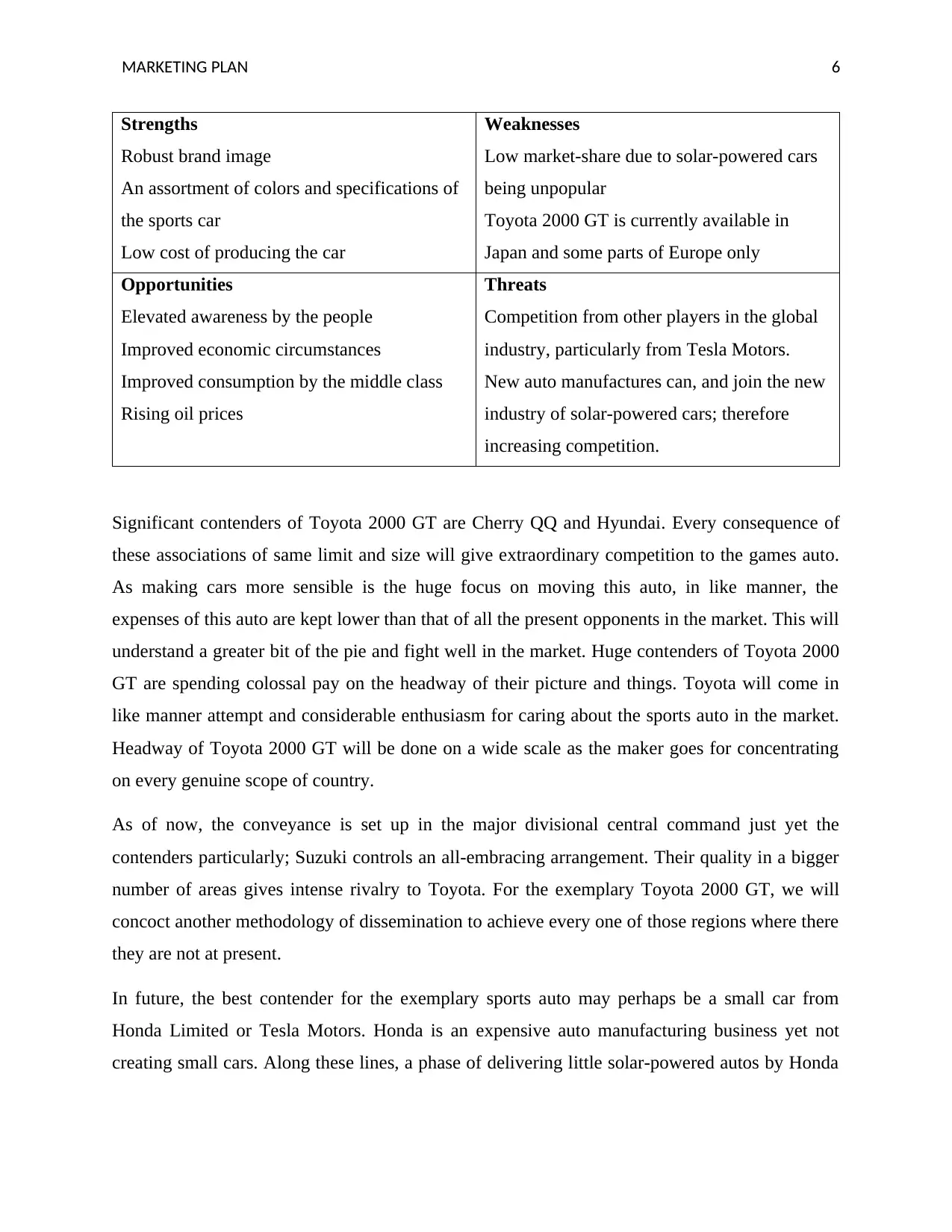
MARKETING PLAN 6
Strengths
Robust brand image
An assortment of colors and specifications of
the sports car
Low cost of producing the car
Weaknesses
Low market-share due to solar-powered cars
being unpopular
Toyota 2000 GT is currently available in
Japan and some parts of Europe only
Opportunities
Elevated awareness by the people
Improved economic circumstances
Improved consumption by the middle class
Rising oil prices
Threats
Competition from other players in the global
industry, particularly from Tesla Motors.
New auto manufactures can, and join the new
industry of solar-powered cars; therefore
increasing competition.
Significant contenders of Toyota 2000 GT are Cherry QQ and Hyundai. Every consequence of
these associations of same limit and size will give extraordinary competition to the games auto.
As making cars more sensible is the huge focus on moving this auto, in like manner, the
expenses of this auto are kept lower than that of all the present opponents in the market. This will
understand a greater bit of the pie and fight well in the market. Huge contenders of Toyota 2000
GT are spending colossal pay on the headway of their picture and things. Toyota will come in
like manner attempt and considerable enthusiasm for caring about the sports auto in the market.
Headway of Toyota 2000 GT will be done on a wide scale as the maker goes for concentrating
on every genuine scope of country.
As of now, the conveyance is set up in the major divisional central command just yet the
contenders particularly; Suzuki controls an all-embracing arrangement. Their quality in a bigger
number of areas gives intense rivalry to Toyota. For the exemplary Toyota 2000 GT, we will
concoct another methodology of dissemination to achieve every one of those regions where there
they are not at present.
In future, the best contender for the exemplary sports auto may perhaps be a small car from
Honda Limited or Tesla Motors. Honda is an expensive auto manufacturing business yet not
creating small cars. Along these lines, a phase of delivering little solar-powered autos by Honda
Strengths
Robust brand image
An assortment of colors and specifications of
the sports car
Low cost of producing the car
Weaknesses
Low market-share due to solar-powered cars
being unpopular
Toyota 2000 GT is currently available in
Japan and some parts of Europe only
Opportunities
Elevated awareness by the people
Improved economic circumstances
Improved consumption by the middle class
Rising oil prices
Threats
Competition from other players in the global
industry, particularly from Tesla Motors.
New auto manufactures can, and join the new
industry of solar-powered cars; therefore
increasing competition.
Significant contenders of Toyota 2000 GT are Cherry QQ and Hyundai. Every consequence of
these associations of same limit and size will give extraordinary competition to the games auto.
As making cars more sensible is the huge focus on moving this auto, in like manner, the
expenses of this auto are kept lower than that of all the present opponents in the market. This will
understand a greater bit of the pie and fight well in the market. Huge contenders of Toyota 2000
GT are spending colossal pay on the headway of their picture and things. Toyota will come in
like manner attempt and considerable enthusiasm for caring about the sports auto in the market.
Headway of Toyota 2000 GT will be done on a wide scale as the maker goes for concentrating
on every genuine scope of country.
As of now, the conveyance is set up in the major divisional central command just yet the
contenders particularly; Suzuki controls an all-embracing arrangement. Their quality in a bigger
number of areas gives intense rivalry to Toyota. For the exemplary Toyota 2000 GT, we will
concoct another methodology of dissemination to achieve every one of those regions where there
they are not at present.
In future, the best contender for the exemplary sports auto may perhaps be a small car from
Honda Limited or Tesla Motors. Honda is an expensive auto manufacturing business yet not
creating small cars. Along these lines, a phase of delivering little solar-powered autos by Honda
⊘ This is a preview!⊘
Do you want full access?
Subscribe today to unlock all pages.

Trusted by 1+ million students worldwide
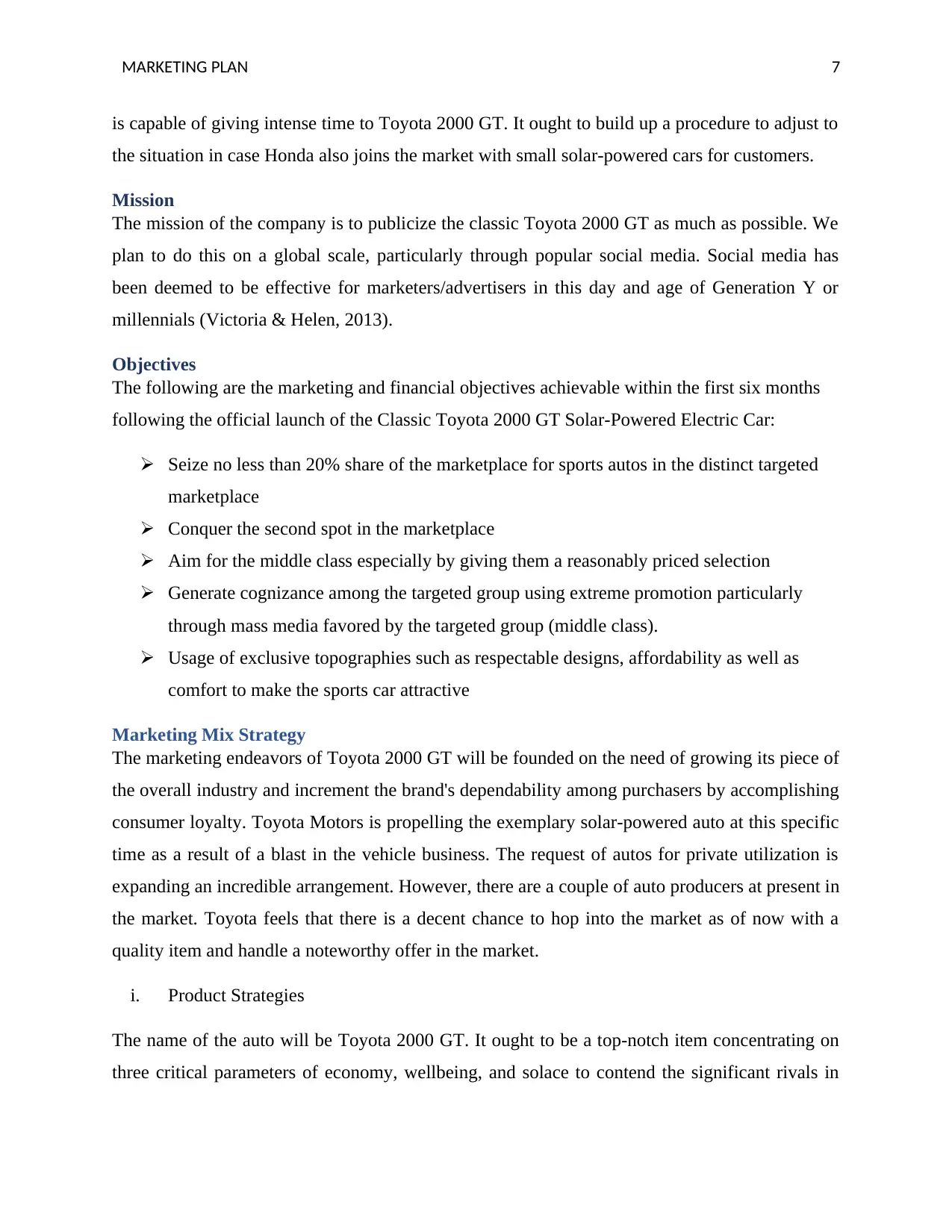
MARKETING PLAN 7
is capable of giving intense time to Toyota 2000 GT. It ought to build up a procedure to adjust to
the situation in case Honda also joins the market with small solar-powered cars for customers.
Mission
The mission of the company is to publicize the classic Toyota 2000 GT as much as possible. We
plan to do this on a global scale, particularly through popular social media. Social media has
been deemed to be effective for marketers/advertisers in this day and age of Generation Y or
millennials (Victoria & Helen, 2013).
Objectives
The following are the marketing and financial objectives achievable within the first six months
following the official launch of the Classic Toyota 2000 GT Solar-Powered Electric Car:
Seize no less than 20% share of the marketplace for sports autos in the distinct targeted
marketplace
Conquer the second spot in the marketplace
Aim for the middle class especially by giving them a reasonably priced selection
Generate cognizance among the targeted group using extreme promotion particularly
through mass media favored by the targeted group (middle class).
Usage of exclusive topographies such as respectable designs, affordability as well as
comfort to make the sports car attractive
Marketing Mix Strategy
The marketing endeavors of Toyota 2000 GT will be founded on the need of growing its piece of
the overall industry and increment the brand's dependability among purchasers by accomplishing
consumer loyalty. Toyota Motors is propelling the exemplary solar-powered auto at this specific
time as a result of a blast in the vehicle business. The request of autos for private utilization is
expanding an incredible arrangement. However, there are a couple of auto producers at present in
the market. Toyota feels that there is a decent chance to hop into the market as of now with a
quality item and handle a noteworthy offer in the market.
i. Product Strategies
The name of the auto will be Toyota 2000 GT. It ought to be a top-notch item concentrating on
three critical parameters of economy, wellbeing, and solace to contend the significant rivals in
is capable of giving intense time to Toyota 2000 GT. It ought to build up a procedure to adjust to
the situation in case Honda also joins the market with small solar-powered cars for customers.
Mission
The mission of the company is to publicize the classic Toyota 2000 GT as much as possible. We
plan to do this on a global scale, particularly through popular social media. Social media has
been deemed to be effective for marketers/advertisers in this day and age of Generation Y or
millennials (Victoria & Helen, 2013).
Objectives
The following are the marketing and financial objectives achievable within the first six months
following the official launch of the Classic Toyota 2000 GT Solar-Powered Electric Car:
Seize no less than 20% share of the marketplace for sports autos in the distinct targeted
marketplace
Conquer the second spot in the marketplace
Aim for the middle class especially by giving them a reasonably priced selection
Generate cognizance among the targeted group using extreme promotion particularly
through mass media favored by the targeted group (middle class).
Usage of exclusive topographies such as respectable designs, affordability as well as
comfort to make the sports car attractive
Marketing Mix Strategy
The marketing endeavors of Toyota 2000 GT will be founded on the need of growing its piece of
the overall industry and increment the brand's dependability among purchasers by accomplishing
consumer loyalty. Toyota Motors is propelling the exemplary solar-powered auto at this specific
time as a result of a blast in the vehicle business. The request of autos for private utilization is
expanding an incredible arrangement. However, there are a couple of auto producers at present in
the market. Toyota feels that there is a decent chance to hop into the market as of now with a
quality item and handle a noteworthy offer in the market.
i. Product Strategies
The name of the auto will be Toyota 2000 GT. It ought to be a top-notch item concentrating on
three critical parameters of economy, wellbeing, and solace to contend the significant rivals in
Paraphrase This Document
Need a fresh take? Get an instant paraphrase of this document with our AI Paraphraser
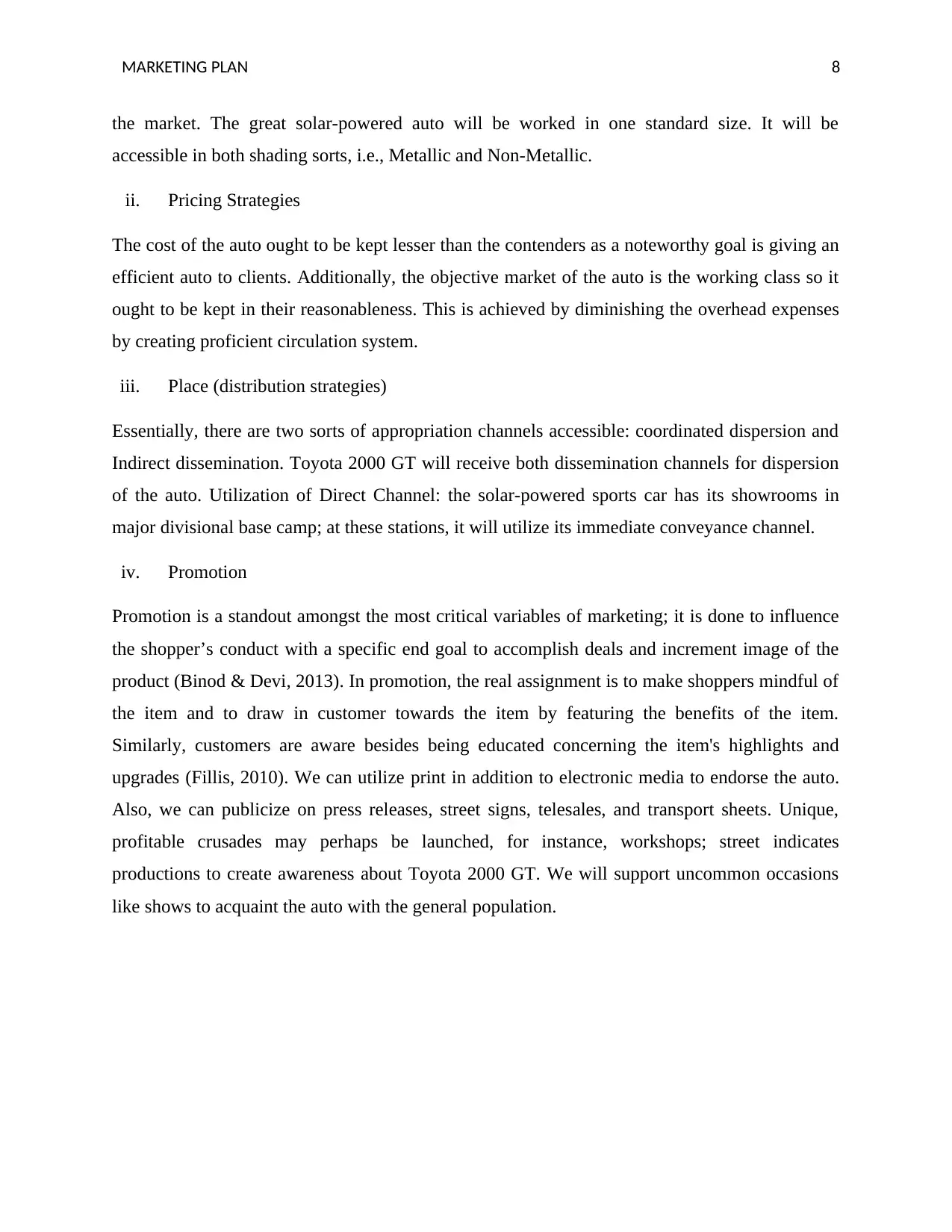
MARKETING PLAN 8
the market. The great solar-powered auto will be worked in one standard size. It will be
accessible in both shading sorts, i.e., Metallic and Non-Metallic.
ii. Pricing Strategies
The cost of the auto ought to be kept lesser than the contenders as a noteworthy goal is giving an
efficient auto to clients. Additionally, the objective market of the auto is the working class so it
ought to be kept in their reasonableness. This is achieved by diminishing the overhead expenses
by creating proficient circulation system.
iii. Place (distribution strategies)
Essentially, there are two sorts of appropriation channels accessible: coordinated dispersion and
Indirect dissemination. Toyota 2000 GT will receive both dissemination channels for dispersion
of the auto. Utilization of Direct Channel: the solar-powered sports car has its showrooms in
major divisional base camp; at these stations, it will utilize its immediate conveyance channel.
iv. Promotion
Promotion is a standout amongst the most critical variables of marketing; it is done to influence
the shopper’s conduct with a specific end goal to accomplish deals and increment image of the
product (Binod & Devi, 2013). In promotion, the real assignment is to make shoppers mindful of
the item and to draw in customer towards the item by featuring the benefits of the item.
Similarly, customers are aware besides being educated concerning the item's highlights and
upgrades (Fillis, 2010). We can utilize print in addition to electronic media to endorse the auto.
Also, we can publicize on press releases, street signs, telesales, and transport sheets. Unique,
profitable crusades may perhaps be launched, for instance, workshops; street indicates
productions to create awareness about Toyota 2000 GT. We will support uncommon occasions
like shows to acquaint the auto with the general population.
the market. The great solar-powered auto will be worked in one standard size. It will be
accessible in both shading sorts, i.e., Metallic and Non-Metallic.
ii. Pricing Strategies
The cost of the auto ought to be kept lesser than the contenders as a noteworthy goal is giving an
efficient auto to clients. Additionally, the objective market of the auto is the working class so it
ought to be kept in their reasonableness. This is achieved by diminishing the overhead expenses
by creating proficient circulation system.
iii. Place (distribution strategies)
Essentially, there are two sorts of appropriation channels accessible: coordinated dispersion and
Indirect dissemination. Toyota 2000 GT will receive both dissemination channels for dispersion
of the auto. Utilization of Direct Channel: the solar-powered sports car has its showrooms in
major divisional base camp; at these stations, it will utilize its immediate conveyance channel.
iv. Promotion
Promotion is a standout amongst the most critical variables of marketing; it is done to influence
the shopper’s conduct with a specific end goal to accomplish deals and increment image of the
product (Binod & Devi, 2013). In promotion, the real assignment is to make shoppers mindful of
the item and to draw in customer towards the item by featuring the benefits of the item.
Similarly, customers are aware besides being educated concerning the item's highlights and
upgrades (Fillis, 2010). We can utilize print in addition to electronic media to endorse the auto.
Also, we can publicize on press releases, street signs, telesales, and transport sheets. Unique,
profitable crusades may perhaps be launched, for instance, workshops; street indicates
productions to create awareness about Toyota 2000 GT. We will support uncommon occasions
like shows to acquaint the auto with the general population.
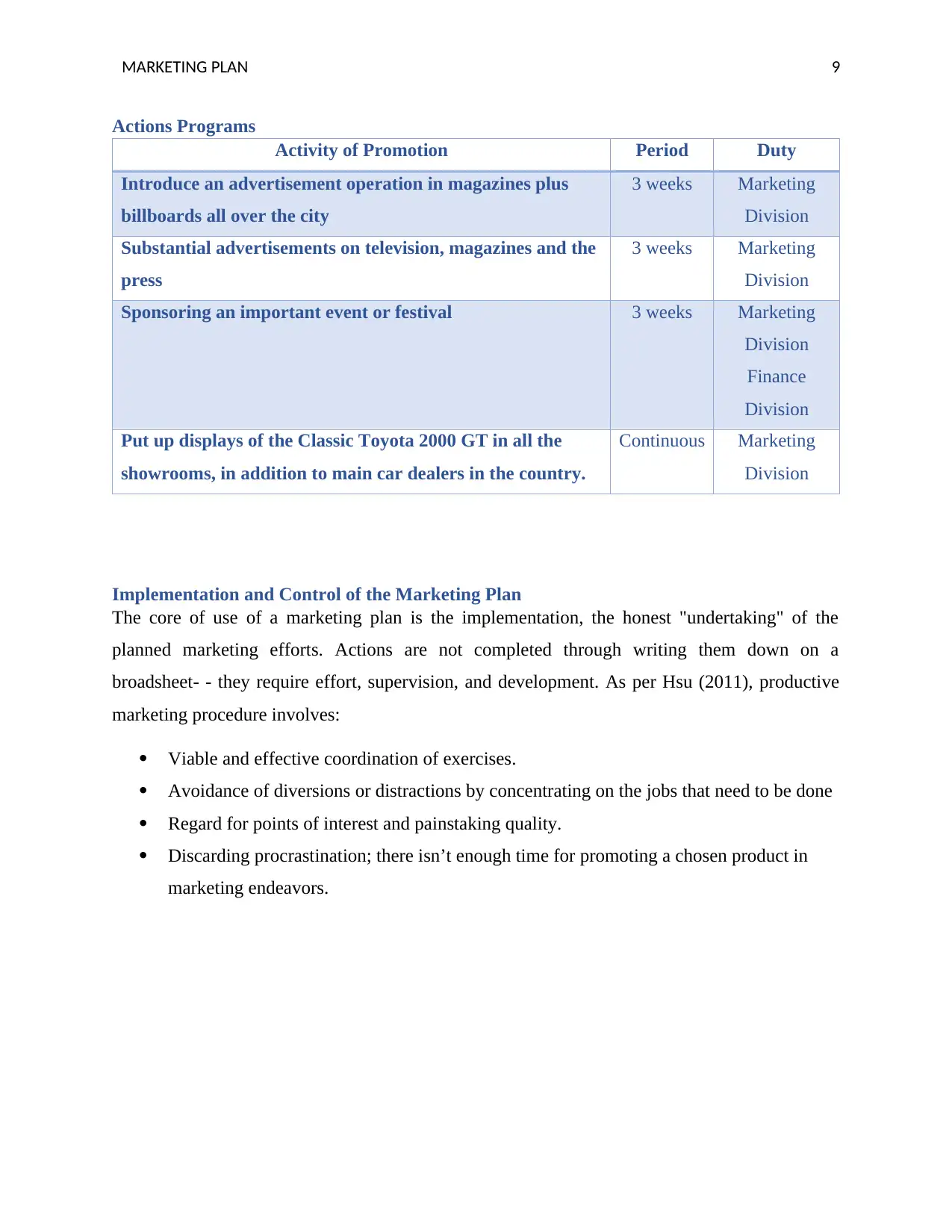
MARKETING PLAN 9
Actions Programs
Activity of Promotion Period Duty
Introduce an advertisement operation in magazines plus
billboards all over the city
3 weeks Marketing
Division
Substantial advertisements on television, magazines and the
press
3 weeks Marketing
Division
Sponsoring an important event or festival 3 weeks Marketing
Division
Finance
Division
Put up displays of the Classic Toyota 2000 GT in all the
showrooms, in addition to main car dealers in the country.
Continuous Marketing
Division
Implementation and Control of the Marketing Plan
The core of use of a marketing plan is the implementation, the honest "undertaking" of the
planned marketing efforts. Actions are not completed through writing them down on a
broadsheet- - they require effort, supervision, and development. As per Hsu (2011), productive
marketing procedure involves:
Viable and effective coordination of exercises.
Avoidance of diversions or distractions by concentrating on the jobs that need to be done
Regard for points of interest and painstaking quality.
Discarding procrastination; there isn’t enough time for promoting a chosen product in
marketing endeavors.
Actions Programs
Activity of Promotion Period Duty
Introduce an advertisement operation in magazines plus
billboards all over the city
3 weeks Marketing
Division
Substantial advertisements on television, magazines and the
press
3 weeks Marketing
Division
Sponsoring an important event or festival 3 weeks Marketing
Division
Finance
Division
Put up displays of the Classic Toyota 2000 GT in all the
showrooms, in addition to main car dealers in the country.
Continuous Marketing
Division
Implementation and Control of the Marketing Plan
The core of use of a marketing plan is the implementation, the honest "undertaking" of the
planned marketing efforts. Actions are not completed through writing them down on a
broadsheet- - they require effort, supervision, and development. As per Hsu (2011), productive
marketing procedure involves:
Viable and effective coordination of exercises.
Avoidance of diversions or distractions by concentrating on the jobs that need to be done
Regard for points of interest and painstaking quality.
Discarding procrastination; there isn’t enough time for promoting a chosen product in
marketing endeavors.
⊘ This is a preview!⊘
Do you want full access?
Subscribe today to unlock all pages.

Trusted by 1+ million students worldwide
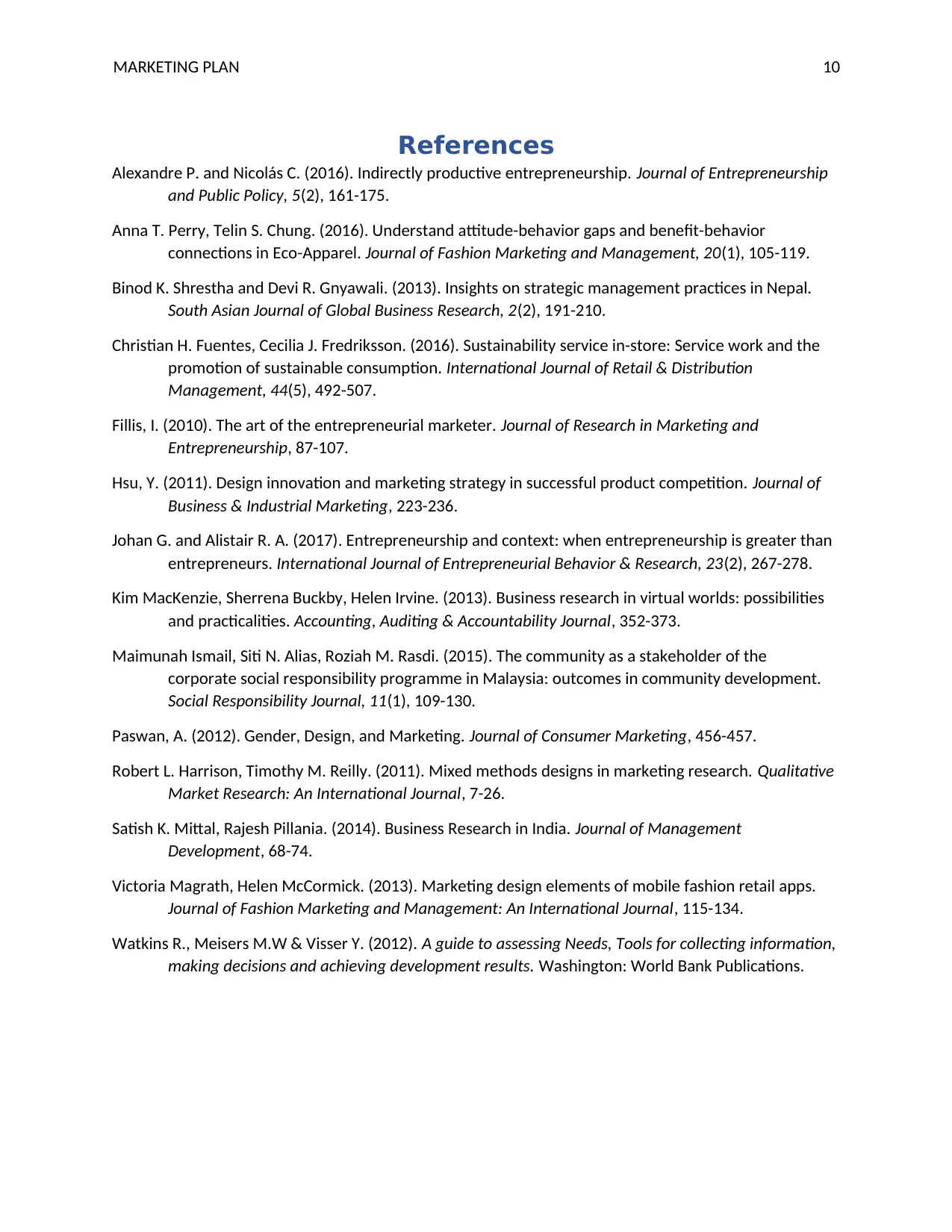
MARKETING PLAN 10
References
Alexandre P. and Nicolás C. (2016). Indirectly productive entrepreneurship. Journal of Entrepreneurship
and Public Policy, 5(2), 161-175.
Anna T. Perry, Telin S. Chung. (2016). Understand attitude-behavior gaps and benefit-behavior
connections in Eco-Apparel. Journal of Fashion Marketing and Management, 20(1), 105-119.
Binod K. Shrestha and Devi R. Gnyawali. (2013). Insights on strategic management practices in Nepal.
South Asian Journal of Global Business Research, 2(2), 191-210.
Christian H. Fuentes, Cecilia J. Fredriksson. (2016). Sustainability service in-store: Service work and the
promotion of sustainable consumption. International Journal of Retail & Distribution
Management, 44(5), 492-507.
Fillis, I. (2010). The art of the entrepreneurial marketer. Journal of Research in Marketing and
Entrepreneurship, 87-107.
Hsu, Y. (2011). Design innovation and marketing strategy in successful product competition. Journal of
Business & Industrial Marketing, 223-236.
Johan G. and Alistair R. A. (2017). Entrepreneurship and context: when entrepreneurship is greater than
entrepreneurs. International Journal of Entrepreneurial Behavior & Research, 23(2), 267-278.
Kim MacKenzie, Sherrena Buckby, Helen Irvine. (2013). Business research in virtual worlds: possibilities
and practicalities. Accounting, Auditing & Accountability Journal, 352-373.
Maimunah Ismail, Siti N. Alias, Roziah M. Rasdi. (2015). The community as a stakeholder of the
corporate social responsibility programme in Malaysia: outcomes in community development.
Social Responsibility Journal, 11(1), 109-130.
Paswan, A. (2012). Gender, Design, and Marketing. Journal of Consumer Marketing, 456-457.
Robert L. Harrison, Timothy M. Reilly. (2011). Mixed methods designs in marketing research. Qualitative
Market Research: An International Journal, 7-26.
Satish K. Mittal, Rajesh Pillania. (2014). Business Research in India. Journal of Management
Development, 68-74.
Victoria Magrath, Helen McCormick. (2013). Marketing design elements of mobile fashion retail apps.
Journal of Fashion Marketing and Management: An International Journal, 115-134.
Watkins R., Meisers M.W & Visser Y. (2012). A guide to assessing Needs, Tools for collecting information,
making decisions and achieving development results. Washington: World Bank Publications.
References
Alexandre P. and Nicolás C. (2016). Indirectly productive entrepreneurship. Journal of Entrepreneurship
and Public Policy, 5(2), 161-175.
Anna T. Perry, Telin S. Chung. (2016). Understand attitude-behavior gaps and benefit-behavior
connections in Eco-Apparel. Journal of Fashion Marketing and Management, 20(1), 105-119.
Binod K. Shrestha and Devi R. Gnyawali. (2013). Insights on strategic management practices in Nepal.
South Asian Journal of Global Business Research, 2(2), 191-210.
Christian H. Fuentes, Cecilia J. Fredriksson. (2016). Sustainability service in-store: Service work and the
promotion of sustainable consumption. International Journal of Retail & Distribution
Management, 44(5), 492-507.
Fillis, I. (2010). The art of the entrepreneurial marketer. Journal of Research in Marketing and
Entrepreneurship, 87-107.
Hsu, Y. (2011). Design innovation and marketing strategy in successful product competition. Journal of
Business & Industrial Marketing, 223-236.
Johan G. and Alistair R. A. (2017). Entrepreneurship and context: when entrepreneurship is greater than
entrepreneurs. International Journal of Entrepreneurial Behavior & Research, 23(2), 267-278.
Kim MacKenzie, Sherrena Buckby, Helen Irvine. (2013). Business research in virtual worlds: possibilities
and practicalities. Accounting, Auditing & Accountability Journal, 352-373.
Maimunah Ismail, Siti N. Alias, Roziah M. Rasdi. (2015). The community as a stakeholder of the
corporate social responsibility programme in Malaysia: outcomes in community development.
Social Responsibility Journal, 11(1), 109-130.
Paswan, A. (2012). Gender, Design, and Marketing. Journal of Consumer Marketing, 456-457.
Robert L. Harrison, Timothy M. Reilly. (2011). Mixed methods designs in marketing research. Qualitative
Market Research: An International Journal, 7-26.
Satish K. Mittal, Rajesh Pillania. (2014). Business Research in India. Journal of Management
Development, 68-74.
Victoria Magrath, Helen McCormick. (2013). Marketing design elements of mobile fashion retail apps.
Journal of Fashion Marketing and Management: An International Journal, 115-134.
Watkins R., Meisers M.W & Visser Y. (2012). A guide to assessing Needs, Tools for collecting information,
making decisions and achieving development results. Washington: World Bank Publications.
1 out of 10
Your All-in-One AI-Powered Toolkit for Academic Success.
+13062052269
info@desklib.com
Available 24*7 on WhatsApp / Email
![[object Object]](/_next/static/media/star-bottom.7253800d.svg)
Unlock your academic potential
Copyright © 2020–2025 A2Z Services. All Rights Reserved. Developed and managed by ZUCOL.


